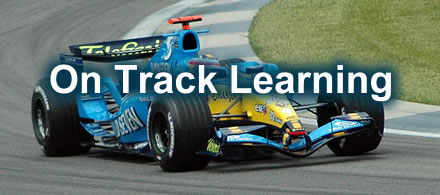
Lesson 8: Calculating Slope (Mathematics)

Teacher Lesson Plan
Approximate length of time: 45 minutes
Background information on the topic: Student will need to know how to measure slope.
Introductory brainteaser/mini-activity: Talk about why slope is important and when we use slope: hills, roads, sports fields, ski slopes.
Outline of the activity: Worksheet on figuring slope. Group activity with student assignments of driver/timer, measurement person and data recorder.
- set-up ramp
- take measurements
- release and time car (for greater accuracy, have 3 students time each trial and average the results.
- record data
- adjust to new height
- repeat steps 1 - 5
Outline of student expectations:
Students will build ramp, share predictions, share observations, record measurements, discuss results and list situations where slope is measured.
Student materials:
Handout with procedures and data collection chart.
Connections with other disciplines:
Science
Student Worksheets
Name ________________________ Slope
During this activity you will calculate the slope of a ramp and determine the time it takes a vehicle to travel down the ramp.
Procedures:
1) Build a ramp. Take a board and put two textbooks under one end of the board. To prevent you from having to chase the car after each release, place the lower end near the wall (but not up against it).
2) Measure the rise – the distance from the highest point on the ramp straight to the floor. Mark this spot on the floor with tape. You will need to use this same point to measure run. Record this measurement.
3) Measure the run – the distance along the floor from where the ramp touches the floor to the point on the floor where you marked the rise in Procedure 2. Record this measurement.
4) Calculate the value of the slope. Slope = rise ÷ run. Record the result.
5) To determine the time it takes for the car to travel down the ramp, designate three people to be timers and one person to release the car. The timers will measure the time from when the car is released until the back wheels leave the ramp. Average the three times and record your results.
(A refresher from previous math classes: An outlier is a piece of data that is considerably different in value than the rest of the data. When comparing the three times check for an outlier. If repeating the experiment will provide more accurate data, then release and time again before changing the ramp.)
6) For the second trial, add two more books and repeat steps 1 – 5.
7) For the third trial, add two more books and repeat steps 1 – 5.
|
Time Trial |
Rise |
Run |
Slope |
Time |
|
#1 |
||||
|
#2 |
||||
|
#3 |
Answer the following questions:
- In examining the data, what is the relationship between the values of rise and run?
- In your own words, what is slope?
- What impact does slope have on the time it takes the car to go down the ramp?
- Where does slope have an impact in your life?
National Science Standards
- All students should develop abilities necessary to do scientific inquiry and understandings about scientific inquiry.
- All students should develop abilities of technological design and understandings about science and technology.
- All students should develop understanding of science and technology in society.
Science Background information
Teaser: Divide the class into 6 groups and ask the students to think of as examples of slope as possible in 5 minutes (hill, racetrack, football field, ramp, lawn, road). Have each group report their findings and comment on why it is important to calculate slope.
Student Expectations: Each member of the group will need to calculate the slopes at different heights (12, 24, & 36 inches) and measure each angle Determine the relationship between slope andspeed.
Standard Course of Study Objectives
- 1.01 Develop flexibility in solving problems by selecting strategies and using mental computation, estimation, calculators or computer, and paper and pencil.
- 1.02 Develop flexibility in solving problems by selecting strategies and using mental computation, estimation, calculators or computers, and paper and pencil.
- 2.01 Determine the effect on perimeter, area or volume when one or more dimensions of two- and three-dimensional figures are changed.
- 3.01 Represent problem situation with geometric models.
- 3.02 Apply geometric properties and relationships including the Pythagorean theorem, to solve problems.
- 5.01 Develop an understanding of functions.
- Boards to be used as ramps
- Textbooks for raising the ramp
- Car for each group
- Measure tape or meter stick
- Data Sheet
- Stopwatch

